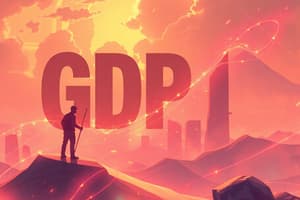Podcast
Questions and Answers
Which of the following best describes economic development, according to Arthur Lewis?
Which of the following best describes economic development, according to Arthur Lewis?
- An increase in a nation's GDP.
- The enlargement of the range of people's choices. (correct)
- Quantitative changes in an economy.
- Improvements in market productivity.
According to the content, how does economic growth primarily relate to economic development?
According to the content, how does economic growth primarily relate to economic development?
- It serves as the singular determinant of economic development.
- It is entirely distinct and unrelated to economic development.
- It negates the need for economic development.
- It is a component or prerequisite for economic development. (correct)
What is the most accurate interpretation of the phrase 'economic growth means more output, while economic development implies both more output and changes in the technical and institutional agreement by which it is produced and distributed'?
What is the most accurate interpretation of the phrase 'economic growth means more output, while economic development implies both more output and changes in the technical and institutional agreement by which it is produced and distributed'?
- Economic development hinders economic growth by imposing regulations.
- Economic growth focuses solely on increasing production while development encompasses broader structural changes. (correct)
- Economic growth and economic development are synonymous.
- Economic development is merely a subset of economic growth.
What critical insight does the content offer regarding natural resources and economic expansion?
What critical insight does the content offer regarding natural resources and economic expansion?
Why is capital accumulation considered a crucial factor in economic expansion?
Why is capital accumulation considered a crucial factor in economic expansion?
What is the likely impact of technological advancement on economic growth?
What is the likely impact of technological advancement on economic growth?
How does population impacts economic progress?
How does population impacts economic progress?
Which of the following reflects a significant consideration related to the measurement of economic growth?
Which of the following reflects a significant consideration related to the measurement of economic growth?
What might explain the observed correlation between income per head and indicators of human development across countries?
What might explain the observed correlation between income per head and indicators of human development across countries?
What conditions would likely facilitate the percolation of economic growth benefits to the broader population?
What conditions would likely facilitate the percolation of economic growth benefits to the broader population?
How can human development influence population growth?
How can human development influence population growth?
How does Japan, according to the content, serve as example regarding natural resources and growth?
How does Japan, according to the content, serve as example regarding natural resources and growth?
Based on the content, what would you infer about the relationship between saving rates and economic growth?
Based on the content, what would you infer about the relationship between saving rates and economic growth?
According to the content, how do economists see the role of innovation and new technology?
According to the content, how do economists see the role of innovation and new technology?
What is the connection between structural change (e.g., shift from primary to secondary sector) and economic growth?
What is the connection between structural change (e.g., shift from primary to secondary sector) and economic growth?
According to the content, why is the building of human capital necessary to ensure economic growth?
According to the content, why is the building of human capital necessary to ensure economic growth?
Why are social and cultural factors important for promoting economic growth?
Why are social and cultural factors important for promoting economic growth?
Which of the following is more aligned with economic growth rather than economic development?
Which of the following is more aligned with economic growth rather than economic development?
Why might a country's average GDP provide an inadequate metric to analyse human well being?
Why might a country's average GDP provide an inadequate metric to analyse human well being?
If a country wants to decrease population growth, which course of action should it follow, as stated in the content?
If a country wants to decrease population growth, which course of action should it follow, as stated in the content?
Flashcards
Economic Growth
Economic Growth
Increase in a nation's production of goods and services over time, measured by real GDP growth.
Economic Development
Economic Development
Improvements in a nation's health, education, and overall well-being.
Economic Development
Economic Development
Quantitative & qualitative changes in the economy.
Economic Growth Pitfalls
Economic Growth Pitfalls
Signup and view all the flashcards
Factors of Economic Growth
Factors of Economic Growth
Signup and view all the flashcards
Capital Accumulation
Capital Accumulation
Signup and view all the flashcards
Technological Progress
Technological Progress
Signup and view all the flashcards
Population Growth
Population Growth
Signup and view all the flashcards
Infrastructure
Infrastructure
Signup and view all the flashcards
Human Capital
Human Capital
Signup and view all the flashcards
Social Factors of Growth
Social Factors of Growth
Signup and view all the flashcards
Study Notes
Learning Outcomes
- Basic knowledge of economic growth, economic development, and their affecting factors can be learned
- The difference between economic growth and economic development can be understood
- The roles of natural resources, capital accumulation, technological progress, population, and human capital in economic growth can be identified
- The impact and measurement of economic growth, along with indices for measuring economic development, can be evaluated
- The impact of economic growth on the general population, and the comparison between economic growth and economic development can be analyzed
Introduction
- Economic growth is a relatively recent phenomenon
- The Netherlands was the leading industrial nation from 1580-1820, with an average annual real GDP per worker hour growth of about 0.2%
- The United Kingdom experienced an annual growth of 1.2% from approximately 1820-1890
- The USA has been the leader since 1890, with an average growth rate of 2.2% per year during 1890-1989
- A modest 2% growth doubles a nation's per capita Gross Domestic Product (GDP) in 35 years
- Increase in the market value of goods and services produced by an economy over time is economic growth
- It is conventionally calculated as the percent rate of increase in real GDP
- Economic growth theory refers to growth of potential output, i.e., production at full employment
- Economic growth generally refers to the increase in per capita income
- Economic development focuses on quantitative and qualitative changes during economic advancement
- Economic growth results in more output
- Economic development results in more output, with changes in technical and institutional arrangements
- Growth involves more output from higher amounts of input and greater efficiency, i.e., increase in output per unit of input
Difference between Economic Growth and Economic Development
- Economic development involves quantitative and qualitative changes in the economy
- Arthur Lewis defined economic development as expanding people's choices
- Economic development focuses on health, education, employment, safety, environmental sustainability, social exclusion, gender empowerment, and infrastructure
- Economic growth, measured by GDP or market productivity, is part of economic development, as Amartya Sen stated
- Economic development expands people’s entitlements, capabilities, morbidity, enrichment, literacy, education, and socio-economic indicators
- Economic growth is only one aspect desired by people, including also nutrition, water, health, schooling, transport, shelter, employment, and jobs
- Non-material benefits often valued like freedom to choose, movement, speech, safety, expression, identity, and empowerment are more important than income
- Economic growth can be rapid without improving life quality
- Per capita GDP increase benefits a small population section, leading to wealth concentration, inequality, and dual economies
- Economic growth sets prerequisites for economic development
- Economic growth, with proper resource distribution and institutional mechanisms, ensures qualitative change, environmental sustainability, and economic development
- There is a correlation between income per head and human development indicators
- The use of additional income affects public education, health, and employment which also affect the correlation
- Initial asset distribution determines economic development, benefiting more people if land and education are accessible
- Growth is the increase in goods and services produced and consumed over time
- Growth should apply to poverty reduction, employment, investment, income distribution, environment protection, and leisure
- Growth should consider income, consumption, production, ‘What?”, “To whom?”, “By whom?”, “For what?”, and “When?”
- Growth is abstract, aggregate, and unbounded
- It implies an infinite horizon, with no limits to income increases
- Matters include national income composition, uses, distribution among beneficiaries, efforts, and conditions of production
- Extra resources from growth spent on public health and education contribute to human development
- National income is inadequate for measuring human development because it counts exchanged goods and services, ignoring inside family work and charitable volunteer work
- Public services are counted at cost, doubling wages appears to double welfare
- National income disregards goods and regrettable necessities like military expenditure, anti-crime efforts, or addictive eating/drinking like food and alcohol consumed, as well as diet industry and alcoholism cures.
- Much of what counts as economic growth involves combating evils, fixing blunders, reversing social decay, borrowing, or shifting community/household functions to the market
- Gender inequality affects opportunity to choose family size
- Smaller families are chosen, without adverse effects, when women have opportunities
- Human development through education, reduced infant mortality, and better medical facilities decreases fertility
- More surviving children reduce population growth by reducing family uncertainty
- Human development curbs population growth
- Reduced population growth advances the news ways of economic advancement
- Sudhir Anand and Amartya Sen divided countries into low, medium and high human development levels
- Basic human development Index ranks low-level countries
- Anand and Sen added indicators to life expectancy, literacy, and GDP per head for medium-value countries infant/child mortality (under five) added to longevity; secondary school enrollment added to education; and income poverty incidence added to income.
Factors Affecting Economic Growth
- Natural resources are the principal components for economic growth
- A country's non-availability of natural resources hinders its rapid development
- Abundant resources do not guarantee economic growth
- Resources must be accompanied by exploitation
- Without proper utilization, natural resources is not able to develop
- Technological advancement helps use resources
- Natural resources can augment economic growth through introducing improved technology
- Value depends on usefulness
- Usefulness relies on adapting/updating technology
Capital Accumulation
- The second most important factor in economic growth is capital accumulation
- Capital is a stock of physical reproducible production factors
- Capital accumulation is when capital stock grows over time.
- Capital accumulation is cumulative and self-sustaining if continuous rise in saving, investment in goods, and intermediaries exist to mobilize saving and divert it
Technological Progress
- Technological changes count as a key factor in economic growth
- It refers to changes in production mode through research or innovation
- Changes in technology increase labour, capital, and other factors productivity
- Schumpeter considers innovation the critical technological factor
Population
- Population growth affects economic growth
- Population growth systematically changes with overall development
- Changes in population growth with development are demographic transition
- High population growth requires more effort
- Higher populations lower per capita income growth
- Family planning decreases growth (incentives for few children), and increases education and permits growth
Other Factors
- Infrastructure development is a determining factor in modern economic growth
- Means of transport and communication are key to infrastructure
- Structural changes determine the shape of economic growth
- Transition from a primary sector to modern manufacturing and service sectors is a structural change
- Structural changes should increase employment, labour productivity, capital stock, and promote new ideas, innovation, or research
- Structural changes begin with population transfer from primary to secondary, and then tertiary sector
- Creation of human capital determines growth like skilled labour (scientists, engineers, managers, etc.)
- Shortage of skilled labour hinders development in LDCs
- Overcoming shortages requires scientific, technological, and various institutions to fill those gaps
- Human endowments, social attitudes, political conditions, and historical factors greatly influence the process of growth
- Social, cultural, political, and administrative factors determine the spirit of adventure, discoveries, and invention
Studying That Suits You
Use AI to generate personalized quizzes and flashcards to suit your learning preferences.




